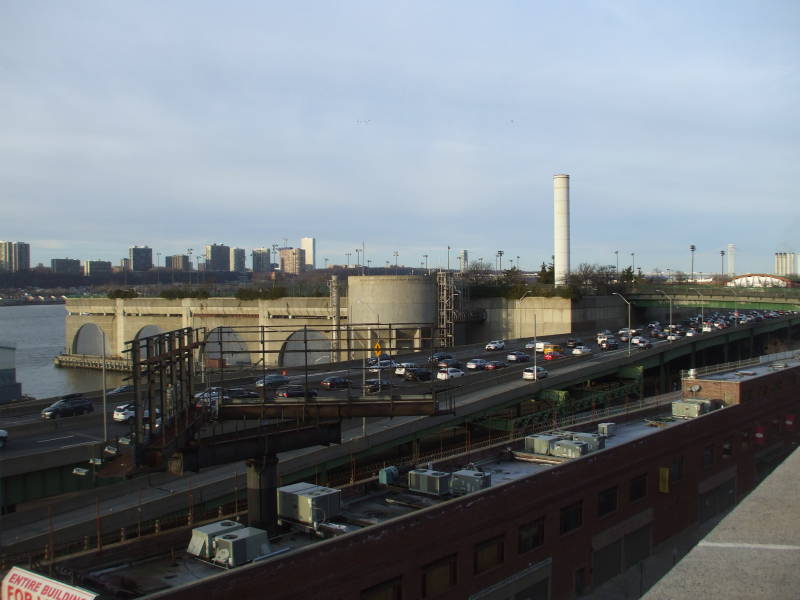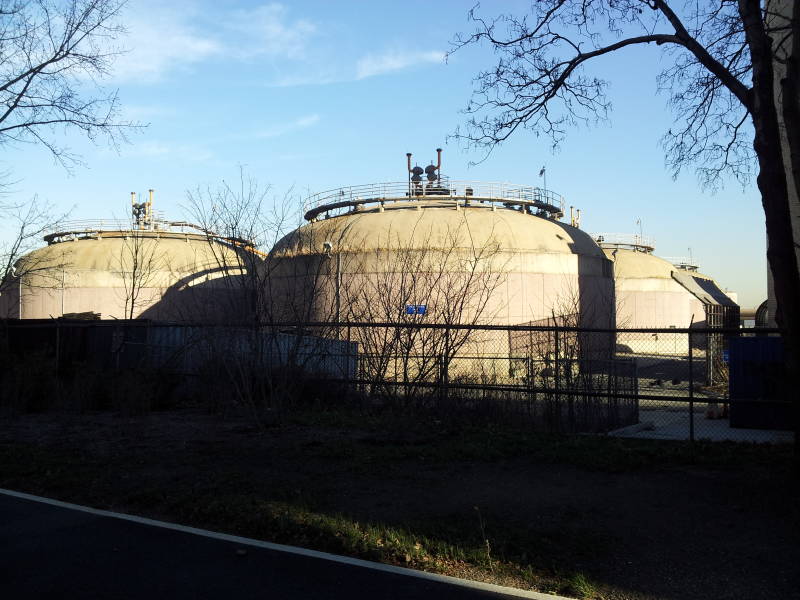
New York City's Water Supply and Sewage Treatment System
Water for New York City
New York's water supply was once limited to some springs and wells on Manhattan. Aaron Burr set up a water-supply scam in order to establish a bank without state approval. It dug a few wells in an area where raw sewage mixed with the water, and carried the contaminated water through hollowed-out tree trunks. After a number of mergers and name changes, that became JPMorgan Chase & Company.
CrotonAqueduct
Meanwhile, polluting industries and a lack of sewers led to cholera epidemics. The Croton Aqueduct bas built in the late 1830s. Clean water started flowing into the city in 1842.
The High Bridge carried the Croton Aqueduct across the Harlem River from Bronx to Manhattan.
Several other remnants of the Croton Aqueduct can still be seen: three gate houses, and manhole covers dating back to the 1860s.
The original Croton Aqueduct carried water to the city until 1955. Meanwhile the New Croton Aqueduct had been built in the late 1880s. It still provides 10% of the city's water. The Catskill Aqueduct and Delaware Aqueduct now supply 40% and 50%, respectively, of the city's water, bringing it by gravity from the Catskill Mountains.
New York City's Wastewater Treatment System
George E. Waring Jr. was an American designer of, and advocate for, drainage systems that keep domestic ewage separate from storm runoff. He was appointed the drainage engineer for the construction of New York City's Central Park in 1857. Much of the area had been a wetland.
Street-Cleaning and the Disposal of a City's Wastes: Methods and Results and the Effect upon Public Health, Public Morals, and Municipal ProsperityAfter the Civil War, he led the construction of a drainage system for Memphis, Tennessee, which was suffering cholera and yellow fever epidemics. Cholera is spread by sewage contamination of drinking water. It wasn't known at the time, but yellow fever is transmitted by mosquitos which breed in stagnant water. Waring's drainage system helped with both.
In 1895, he was hired by New York City, where each day horses soiled the streets with an estimated 2.5 million pounds of manure and 60,000 gallons of urine. Horse carcasses rotted in the streets, where garbage was piled one to two feet deep. Waring established a Street Cleaning Department and greatly improved sanitary conditions. By 1898 he had published a a book on the topic, Street-Cleaning and the Disposal of a City's Wastes.
NYCSewage
Treatment
New York City's Department of Environmental Protection operates 14 wastewater treatment plants to collect and treat 4.9 million cubic meters of wastewater every day.
The city's system is a combined sewer system, meaning that rainwater and septic waste flow into a common system.
Parts of the Jamaica treatment plant were built in 1903, making it the oldest component still operating today. Others were opened as recently as the mid 1980s.
See the dedicated page for details on pretreatment, primary sedimentation, aeration, aerobic digestion, and anaerobic digestion.
Newtown Creek Wastewater Treatment Plant
Newtown Creek is the largest of the city's 14 wastewater treatment plants.
NewtownCreek
WWTP
The Newtown Creek plant is located in an area that was heavily polluted beginning in the mid 1800s. The Greenpoint area of Brooklyn was the main base of Standard Oil. Other industries clustered around the refineries, either to better utilize refinery products and by-products, or to take advantage of the lack of regulation in an already heavily polluted area.
Now the Newtown Creek plant treats wastewater from northeastern Brooklyn, western Queens, and much of Manhattan.
A major upgrade in 1998-2014 increased plant capacity by 50%. It also added a nature walk along Newtown Creek and around one side of the plant.
North River Wastewater Treatment Plant
NorthRiver
WWTP
The North River Wastewater Treatment Plant was built in 1978-1991.
The plant was built on a concrete platform constructed on 2,3000 caissons driven into the bedrock below the Hudson River bed along the west shore of Manhattan.
The plant has a "green roof" which is now the Riverbank State Park. The park has swimming pools, including one of Olympic dimensions. There is a covered skating rink, for roller skating in the summer and ice skating in the winter. There are several sports fields and basketball courts. It also has an 800-seat theater, an athletic center, and a restaurant with views up the Hudson River valley past the George Washington Bridge.
Wards Island Wastewater Treatment Plant
WardsIsland
WWTP
The Wards Island Wastewater Treatment Plant is on Randalls and Wards Island, between Manhattan, Bronx, and Queens, in the estuary system known as the East River, Harlem River, and Hell Gate.
The islands, now joined into one through landfill, have long been home to various city and state social facilities — orphanages, poor houses, hospitals, reform schools, and what in 1899 became the largest psychiatric hospital in the world.
The Triborough Bridge runs on viaducts above the island, joining the boroughs of Manhattan, Bronx, and Queens. Also, the Hell Gate Bridge carries Amtrak's Northeast Corridor Line toward Boston, and also provides the only freight rail link between Long Island and the mainland.
The Wards Island plant opened in 1937, a year after the Triborough Bridge, and another New Deal project.




